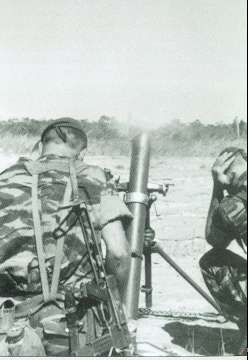MAT-49
| Pistolet-Mitrailleur de 9 mm modèle 1949 (MAT-49) | |
|---|---|
|
MAT-49 on display. This weapon has the front grip lowered in firing position, but lacks a magazine. | |
| Type | Submachine gun |
| Place of origin |
|
| Service history | |
| In service | 1949–present |
| Used by | See Users |
| Wars |
First Indochina War Suez Crisis Algerian War Vietnam War Rhodesian Bush War Shaba II Chadian–Libyan conflict Libyan Civil War[1] Syrian Civil War |
| Production history | |
| Designer | Pierre Monteil |
| Designed | 1949 |
| Produced | 1949–1979 |
| Variants | See Variants |
| Specifications | |
| Weight |
3.5 kg (7.7 lb) [without magazine] 4.2 kg (9.3 lb) [with 32-round magazine] |
| Length | 460 mm / 720 mm (18.1 in / 28.3 in) |
| Barrel length | 230 mm (9.1 in) |
|
| |
| Cartridge |
9×19mm Parabellum 7.62×25mm Tokarev (VPA converted) |
| Caliber | 9mm |
| Action | Blowback, Open bolt |
| Rate of fire | 600 rounds per minute[2] |
| Feed system |
20 or 32 rounds 35 rounds (VPA converted) |
The MAT-49 was a submachine gun which was developed by French arms factory Manufacture Nationale d'Armes de Tulle (MAT) for use by the French Army and was first produced in 1949.
Development
In 1949, after evaluating several prototypes (including a collapsible design from Hotchkiss), the French MAT factory began production of the MAT-49 9 mm submachine gun. The MAT-49 used a machine stamping process which allowed the economical production of large numbers of submachine guns, then urgently required by the French Government for use by Army, French Foreign Legion as well as airborne and colonial forces. Production continued at Tulle until the mid-1960s, then switched to the Manufacture d'Armes de St-Etienne plant (MAS), where the weapon was produced until 1979. In that same year, the French armed forces adopted the FAMAS 5.56 mm assault rifle, and the MAT-49 was gradually phased out of service.
Usage
The MAT-49 saw widespread combat use during the First Indochina War and the Algerian War, as well as the 1956 Suez Crisis.[3] The weapon found considerable favor with airborne and mechanized troops, who prized it for its simplicity, ruggedness, firepower and compactness.
After French forces left Indochina, the People's Army of Vietnam and Viet Minh converted many captured MAT-49s to the Soviet 7.62 mm Tokarev pistol cartridge, then available in large quantities from the Soviet Union and the People's Republic of China. These converted versions could be distinguished by a longer barrel and a higher rate of fire at 900 rpm.[4][5]
Overview
The MAT-49 had a short, retractable wire stock, which when extended gave the weapon a length of 720 millimeters (28 inches), and the magazine well and magazine could be folded forward parallel to the barrel for parachute jump or with a 45° angle hence allowing a safe carry until the magazine well is brought back to vertical position before opening fire. Barrel length is 230 mm (9.1 in), with some police-issue weapons manufactured with extended barrels and non-retractable wooden stocks. As issued, the MAT-49 fires a 9×19mm Parabellum cartridge, using a single-column 20-round magazine for desert use or 32-round similar to the Sten magazine.
The MAT-49 is blowback-operated and box magazine-fed, with a rate of fire of 600 rounds per minute on full auto. The MAT 49/54, a modified MAT-49s manufactured for police forces, had two triggers, allowing use of full-auto fire or single shots, but most were manufactured as full-auto only. Minus magazine, the MAT-49 weighs about 3.5 kilograms (7.7 pounds), which renders it somewhat heavy for a submachine gun. The weapon incorporates a grip safety which is located on the backside of the pistol grip. The rear sights are flip-up and "L"-shaped, and marked for a range of 50 and 100 meters (55 and 109 yd). Production ceased after the introduction of the FAMAS assault rifle in 1979.
Variants
- MAS-48 - prototype variant.
- MAT-49 - main variant.
- MAT-49/54 - gendarme variant with extended barrel and fixed stock.
- MAT-49 silenced - variant fitted with a suppressor.[3]
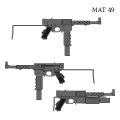 MAT-49: left and right views; view with stock retracted and magazine in safe position
MAT-49: left and right views; view with stock retracted and magazine in safe position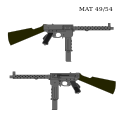 Police MAT-49/54 model
Police MAT-49/54 model
Users
 Algeria[6]
Algeria[6]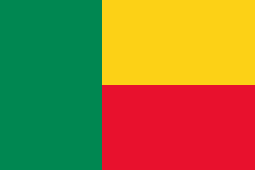 Benin[6]
Benin[6] Bolivia[6]
Bolivia[6]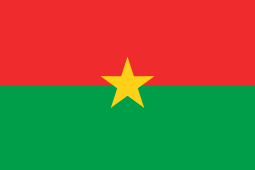 Burkina Faso[6]
Burkina Faso[6] Burundi[6]
Burundi[6]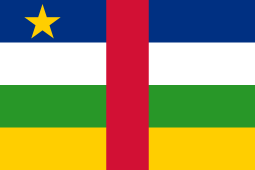 Central African Republic[6]
Central African Republic[6] Chad[6]
Chad[6] Comoros[6]
Comoros[6]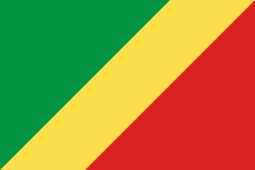 Republic of the Congo[6]
Republic of the Congo[6] Cote d'Ivoire[6]
Cote d'Ivoire[6]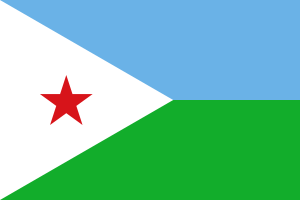 Djibouti[6]
Djibouti[6] Equatorial Guinea[6]
Equatorial Guinea[6] France: Adopted by the French army in 1949.[2] Also used by the National Gendarmerie.[2]
France: Adopted by the French army in 1949.[2] Also used by the National Gendarmerie.[2]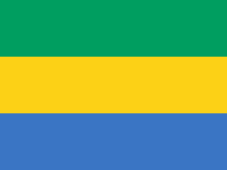 Gabon[6]
Gabon[6]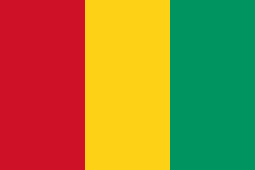 Guinea[6]
Guinea[6]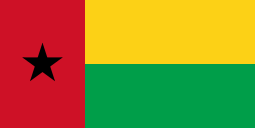 Guinea Bissau
Guinea Bissau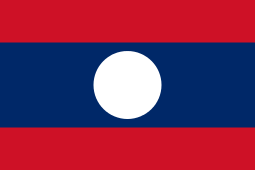 Laos[6]
Laos[6] Lebanon[6]
Lebanon[6]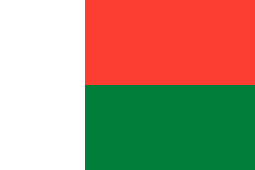 Madagascar[6]
Madagascar[6]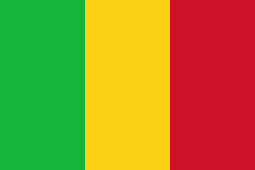 Mali[6] - Armed and Security Forces of Mali
Mali[6] - Armed and Security Forces of Mali Mauritania[6]
Mauritania[6] Morocco[6]
Morocco[6]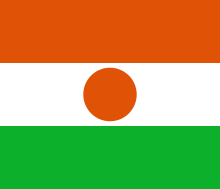 Niger[6]
Niger[6]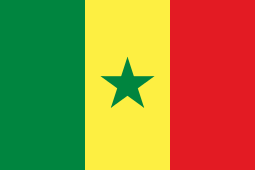 Senegal[6]
Senegal[6] Seychelles[6]
Seychelles[6] Syria: used by police and special forces
Syria: used by police and special forces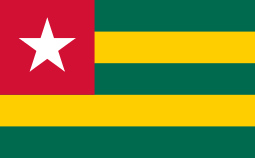 Togo[6]
Togo[6] Tunisia[6]
Tunisia[6] Vietnam: MAT-49s used by being converted to 7.62×25mm Tokarev.[4]
Vietnam: MAT-49s used by being converted to 7.62×25mm Tokarev.[4]
Non-state entities
-
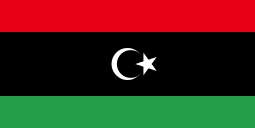 National Liberation Army (Libya)[7]
National Liberation Army (Libya)[7] -
 Zimbabwe African National Liberation Army[8]
Zimbabwe African National Liberation Army[8] -
.svg.png) Viet Minh[9]
Viet Minh[9] -
 ETA: Produced unlicensed copies of existing weapons in an underground workshop at Mouguerre after it was raided by police.[10]
ETA: Produced unlicensed copies of existing weapons in an underground workshop at Mouguerre after it was raided by police.[10]
See also
- Gevarm D4
- Hotchkiss Type Universal
- Sola submachine gun
- Vigneron submachine gun
- MAS-38 replaced in the 1950s by the MAT-49 submachine gun.
References
- ↑ Chivers, C. J. (April 20, 2011). "Inferior Arms Hobble Rebels in Libya War". The New York Times.
- 1 2 3 http://world.guns.ru/smg/fr/mat-49-e.html
- 1 2 http://www.smallarmsreview.com/display.article.cfm?idarticles=2508
- 1 2 http://www.5rar.asn.au/weapons/mat49.htm
- ↑ http://www.virginia1774.org/DIA-ST-HB-07-03-74.pdf
- 1 2 3 4 5 6 7 8 9 10 11 12 13 14 15 16 17 18 19 20 21 22 23 24 25 Jones, Richard D. Jane's Infantry Weapons 2009/2010. Jane's Information Group; 35 edition (January 27, 2009). ISBN 978-0-7106-2869-5.
- ↑ Ackerman, Spencer (April 21, 2011). "Libya's Rebels Fight with Ancient, Useless Weapons". Wired.
- ↑ http://usacac.army.mil/cac2/cgsc/carl/download/csipubs/ArtOfWar_RhodesianAfricanRifles.pdf
- ↑ McNab, Chris (2002). 20th Century Military Uniforms (2nd ed.). Kent: Grange Books. ISBN 1-84013-476-3.
- ↑ (in Spanish)Hallan en Francia un viejo arsenal de subfusiles de ETA de los años 70 elmundo.es
External links
| Wikimedia Commons has media related to MAT-49. |

